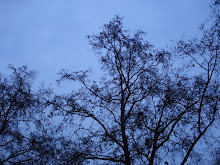
2007-04-27
Huh?

2007-04-22
Sarah Moves to Scotland - Exhibit E - ZZ?
2007-04-15
Sidewalk Sample
2007-04-13
Aurora Borealis (for Adam)



Auroral mechanism
Auroras are now known to be caused by the collision of charged particles (e.g. electrons), found in the magnetosphere, with atoms in the Earth's upper atmosphere (at altitudes above 80 km). These charged particles are typically energized to levels between 1 thousand and 15 thousand electronvolts and, as they collide with atoms of gases in the atmosphere, the atoms become energized. Shortly afterwards, the atoms emit their gained energy as light (see Fluorescence). Light emitted by the Aurora tends to be dominated by emissions from atomic oxygen, resulting in a greenish glow (at a wavelength of 557.7 nm) and - especially at lower energy levels and at higher altitudes - the dark-red glow (at 630.0 nm of wavelength). Both of these represent forbidden transitions of electrons of atomic oxygen that, in absence of newer collisions, persist for a long time and account for the slow brightening and fading (0.5-1 s) of auroral rays. Many other colors - especially those emitted by atomic and molecular nitrogen (blue and purple, respectively) - can also be observed. These, however, vary much faster and reveal the true dynamic nature of auroras.
As well as visible light, auroras emit infrared (NIR and IR) and ultraviolet (UV) rays as well as X-rays (e.g. as observed by the Polar spacecraft). While the visible light emissions of auroras can easily be seen on Earth, the UV and X-ray emissions are best seen from space, as the Earth's atmosphere tends to absorb and attenuate these emissions.
2007-04-12
2007-04-06
Books Acquired and Read - March
Acquired:
- Elements of Style for Screenwriters: The Essential Manual for Writers of Screenplays - Argentini (for Adam)
- Looking Up: Rachel Whiteread's Water Tower - Neri
- Instant Yiddish - Kogos
- The Blizzard Voices - Kooser
- The Poetry Home Repair Manual: Practical Advice for Beginning Poets - Kooser (for Adam)
- The Joys of Yiddish - Rosten
- Collected Stories: One Night in Brazil to The Death of Methuselah - Singer
- In my Father's Court - Singer
- embryoyo - Young
Read:
- Art and Photography - Campany (again)
- Extremely Loud and Incredibly Close - Foer (1/2)
- The Blizzard Voices - Kooser
- New York - Lonely Planet
- Venice - Lonely Planet
- Photography: A Cultural History - Marien (chapter 4, 5 +6)
- The Daily Practice of Painting - Richter (again)
- many many enjoyable books/artcles on Richter (essay due)
- The Joys of Yiddish - Rosten (1/2)














